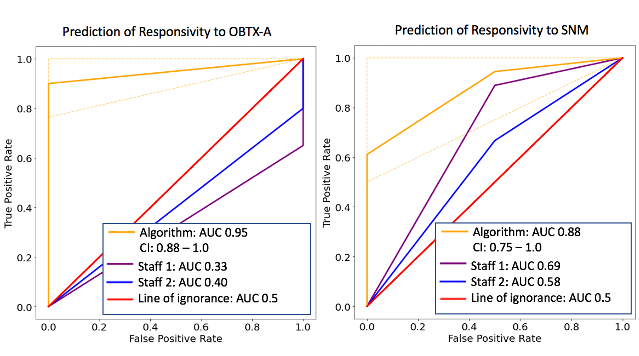Back
Poster, Podium & Video Sessions
Podium
PD34: Urodynamics/Lower Urinary Tract Dysfunction/Female Pelvic Medicine: Female Incontinence: Therapy II
PD34-03: Machine Learning Algorithms are Accurate and Non-inferior to Human Experts in Predicting Medically-Refractory Overactive Bladder Treatment Outcomes
Saturday, May 14, 2022
3:50 PM – 4:00 PM
Location: Room 244
Glenn Werneburg*, Cleveland, OH, Eric Werneburg, Stony Brook, NY, Howard Goldman, Cleveland, OH, Andrew Mullhaupt, Stony Brook, NY, Sandip Vasavada, Cleveland, OH

Glenn T. Werneburg, MD, PHD
Cleveland Clinic
Podium Presenter(s)
Introduction: As information continues to accumulate, the wealth of medical data will become unmanageable for a human to assimilate into an optimal clinical decision without assistance. Machine learning (ML) algorithms “learn” - improve automatically through experience, and draw inferences from training data patterns and generate predictive models. ML’s potential to improve decision-making in urology, and medicine in general, is largely untapped. Utilizing a novel ML approach, we sought to predict treatment response following overactive bladder (OAB) treatments OnabotulinumtoxinA (OBTX-A) injection and sacral neuromodulation (SNM).
Methods: ROSETTA datasets for OAB patients randomized to OBTX-A or SNM were obtained from NICHD. Novel ML algorithms, using reproducing kernel techniques and singular value decomposition entropy with backward elimination, were developed using clinical variables and tasked to predict outcomes including treatment response (=50% reduction in urge urinary incontinence episodes) in validation and test sets. Blinded expert FPMRS urologists predicted outcomes based on the same clinical variables. ROC curves and AUCs were generated for comparison to lines of ignorance and expert human predictions.
Results: Trained algorithms demonstrated outstanding accuracy in predicting treatment responder versus non-responder status (OBTX-A: AUC 0.95; SNM: 0.88), and were noninferior to human experts (Figure). Maximum cystometric capacity (MCC) was identified as the most-pertinent variable, and a novel algorithm containing only MCC accurately predicted treatment response (OBTX-A AUC 0.72; SNM AUC 0.74), and outperformed a standard ML approach XGBOOST (0.54; 0.62), which in turn has consistently outperformed common classification methods including Random Forest. After MCC, the most-pertinent predictive variables included smoking status and history of back surgery and recurrent UTIs.
Conclusions: Novel ML algorithms were accurate, noninferior to expert urologists, and superior to standard ML approaches, in predicting OBTX-A and SNM response in OAB. New predictors of responsivity including volume at maximum cystometric capacity were identified. Such ML techniques and algorithms may serve to complement clinical judgement.
Source of Funding: N/A

Methods: ROSETTA datasets for OAB patients randomized to OBTX-A or SNM were obtained from NICHD. Novel ML algorithms, using reproducing kernel techniques and singular value decomposition entropy with backward elimination, were developed using clinical variables and tasked to predict outcomes including treatment response (=50% reduction in urge urinary incontinence episodes) in validation and test sets. Blinded expert FPMRS urologists predicted outcomes based on the same clinical variables. ROC curves and AUCs were generated for comparison to lines of ignorance and expert human predictions.
Results: Trained algorithms demonstrated outstanding accuracy in predicting treatment responder versus non-responder status (OBTX-A: AUC 0.95; SNM: 0.88), and were noninferior to human experts (Figure). Maximum cystometric capacity (MCC) was identified as the most-pertinent variable, and a novel algorithm containing only MCC accurately predicted treatment response (OBTX-A AUC 0.72; SNM AUC 0.74), and outperformed a standard ML approach XGBOOST (0.54; 0.62), which in turn has consistently outperformed common classification methods including Random Forest. After MCC, the most-pertinent predictive variables included smoking status and history of back surgery and recurrent UTIs.
Conclusions: Novel ML algorithms were accurate, noninferior to expert urologists, and superior to standard ML approaches, in predicting OBTX-A and SNM response in OAB. New predictors of responsivity including volume at maximum cystometric capacity were identified. Such ML techniques and algorithms may serve to complement clinical judgement.
Source of Funding: N/A


.jpg)
.jpg)